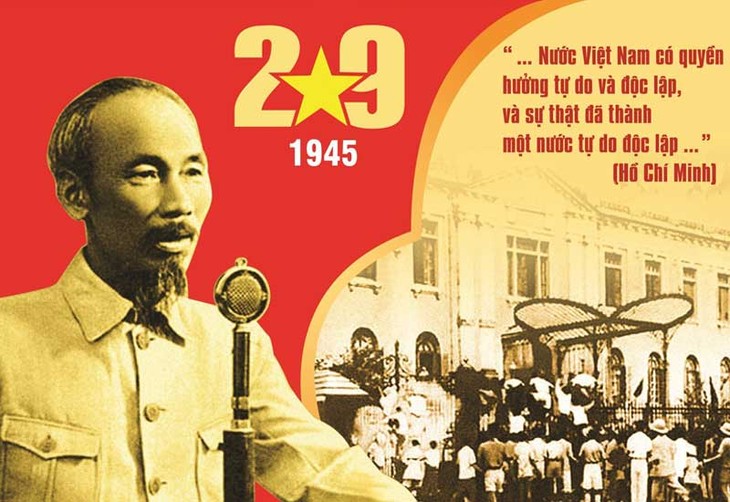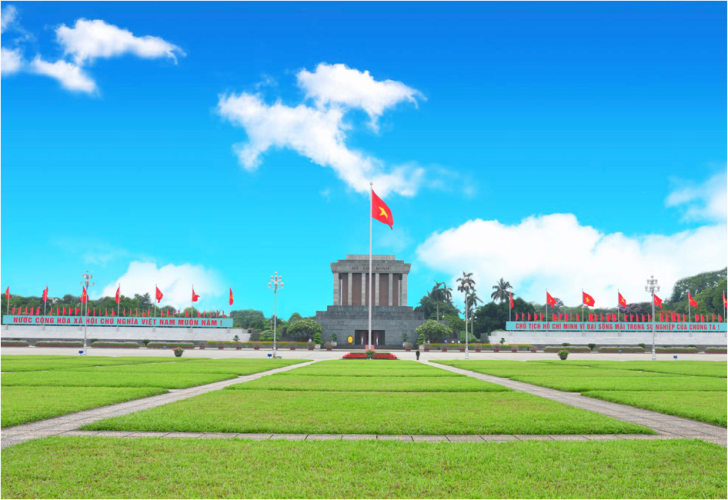(VOVWORLD) -First, we’d like to welcome back Kevin Ryan of the UK to VOV. In his recent correspondence to VOV, Kevin wrote: “I've repaired my shortwave antenna and found your English program. I enjoyed the lovely songs, it’s a nice change from news and commentary. I'm afraid I've lost touch with you over the years - I kept all your beautiful New Year cards in my QSL card album.”
B: Kevin, thanks a lot for coming back. We’re very happy to hear from you again and hope to receive your feedback more regularly. For your information, our program is now also available on the website vovworld.vn and mobile app VOV Media.
A: This week, many listeners shared their interest in the news about the reopening of the HCM Mausoleum and Vietnam-Russia cooperation in preserving the corpse of President Ho Chi Minh.
 Visitors queue to enter the Mausoleum to pay tribute to President Ho Chi Minh. (Photo: Anh Tuan/VNA) Visitors queue to enter the Mausoleum to pay tribute to President Ho Chi Minh. (Photo: Anh Tuan/VNA) |
B: The embalmed body of President Ho Chi Minh remains well-preserved 53 years after his death thanks to the Vietnamese Party, State and government, and Vietnamese and Russian scientists.
A: The protection of President Ho Chi Minh’s corpse has gone through several stages. After his 77th birthday in 1967, the President became weak. The Party Politburo held an extraordinary meeting on caring for the President’s health and preparing to preserve his body after his death. Following that meeting, a number of Vietnamese doctors were sent to the former Soviet Union to learn embalming techniques. After President Ho Chi Minh died, a special team of Vietnamese and Russian experts worked together to embalm the body.
B: The President’s embalmed body is available for viewing at selected times of the year at the Ho Chi Minh Mausoleum, which was inaugurated in 1975. The solemn granite structure is one of the most iconic landmarks in Vietnam’s capital.
A: This week, Bidhan Chandra Sanyal of India told us about India’s 75th Independence Day. He wrote: “Indian people are celebrating the 75th anniversary of their desired independence by paying respect to the freedom fighters and holding discussions, meetings and various social services. India respects the independence and sovereignty of all countries of the world. What about the celebration of Independence Day in Vietnam?”
B: Like Mr. Sanyal, many other listeners this week shared interest in stories about Vietnam’s Independence Day and Ba Dinh square, where President Ho Chi Minh read the Declaration of Independence on September 2, 1945 to give birth to the Democratic Republic of Vietnam, now the Socialist Republic of Vietnam.
 President Ho Chi Minh read the Declaration of Independence of Vietnam on September 2, 1945 President Ho Chi Minh read the Declaration of Independence of Vietnam on September 2, 1945 |
A: 77 years have passed and the emotions of that National Day have been passed from generation to generation as an endless source of inspiration.
B: President Ho Chi Minh’s voice resonating at Ba Dinh square in the autumn of 1945 is embedded in the hearts of every Vietnamese. At that moment, Vietnamese people realized their human value, transformed from slaves to citizens of a free, independent state.
A: Ba Dinh square is the largest square in Vietnam. It is part of the Ba Dinh historical-cultural complex, which includes the sacred Ho Chi Minh Mausoleum. The square is 320 meters long and 100 meters wide and is divided by 1.4-meter-wide paths into 210 grassy squares. At the center of the square stands a 25-meter flag pole flying Vietnam’s national flag, which features a yellow star on a red background.
B: The square was once part of the Thang Long imperial citadel. After the French conquered Indochina in 1894, they built the administrative center for the Indochinese Federation in the area around the square. A flower garden named the Pugininer garden was built in its center.
 Ba Dinh square in front of the Ho Chi Minh Mausoleum (photo: bqllang,gov.vn) Ba Dinh square in front of the Ho Chi Minh Mausoleum (photo: bqllang,gov.vn) |
A: After the August revolution, Hanoi Mayor Tran Van Lai decided to rename the Pugininer garden. He chose the name Ba Dinh garden to commemorate a late 19th century uprising against the French colonialists in the Ba Dinh area of Nga Son district, Thanh Hoa province.
B: Ba Dinh square had several other previous names. As this was where President Ho Chi Minh read Vietnam’s Declaration of Independence, Ba Dinh garden was renamed Independence garden in December 1945. It was named Hong Bang garden when French rule returned, but on October 10, 1954, when Hanoi was liberated for good, the municipal People’s Committee pronounced it Ba Dinh garden again, and then Ba Dinh square.
A: Next to Ba Dinh square stands the Presidential Palace, the Ba Dinh Grand Hall, and the National Assembly Building.
B: This week, VOVWorld received more than 300 letters and emails from listeners in 35 countries and territories.
A: Juan Franco Crespo of Spain wrote: “The Letter Box is a thread connecting the radio station, Vietnam and the brave Vietnamese people with thousands of listeners around the world.”
B: Diego Echeverri of Spain wrote: “The Voice of Vietnam is one of my beloved foreign radio stations. I hope that I can visit Vietnam one day and hope to receive you in my home town of Tamesis.”
A: Johnny Antonio Ramírez López of Peru expressed his interest in our story about the traditional houses of the Nung ethnic minority in Lao Cai province. He wrote: “I admire Nung people for their intelligence, their love for their homeland and their efforts to preserve their culture. All these things make us closer to our ancestors and teach us how to live a better life.”
B: We’d like to acknowledge letters and emails from Fumito Hokamura of Japan, Ratan Kumar Paul, Siddhartha Bhattacharjee, and Sanil Deep of India, Saleem Akhtar Chadhar of Pakistan and all other listeners who sent us emails or posted comments on our Facebook fanpage, VOV5 English Service.
A: That concludes today’s program. We welcome your feedback at: English Service, VOVWorld, the Voice of Vietnam, 45 Ba Trieu street, Hanoi, Vietnam. Or you can email us at: englishsection@vov.vn. You’re invited to visit us online at vovworld.vn, where you can hear both live and recorded programs.
B: Check out our VOV Media App, available on both the IOS and Android platforms, to hear our live broadcasts. We look forward to your feedback on the mobile version of vovworld.vn. Once again, thank you all for listening. Goodbye.